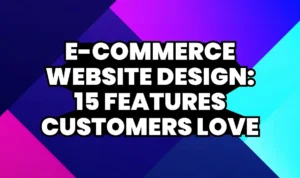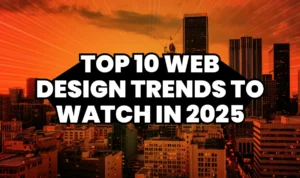In today’s competitive digital landscape, staying ahead means embracing the latest web design trends that shape how users interact with websites. A modern website is more than just a visual asset—it’s a strategic tool that influences brand image, user engagement, and even SEO rankings. If your business wants to remain competitive, knowing the trends driving the next wave of web experiences is essential.
Whether you’re a startup or an established enterprise, your website often serves as the first touchpoint with potential clients. A poorly designed site can hurt conversions, while a cutting-edge one can transform your entire online presence. At Devsking, we’ve helped numerous brands adopt the latest web design trends to increase engagement and ROI.
1. Minimalist Web Design Trends for Clarity and Speed
Minimalism is one of the dominant web design trends reshaping the industry. Clean layouts, generous white space, and simple typography not only create a visually pleasing interface but also improve loading speed and user focus.
Brands adopting minimalistic design often report better user engagement because clutter-free interfaces reduce distractions. Faster load times also enhance SEO, as search engines prioritize websites that provide seamless user experiences.
2. Dark Mode Design: A Stylish and User-Friendly Trend
Dark mode is no longer a passing fad—it’s a full-fledged standard in web design trends. It offers a sleek, modern look, reduces eye strain, and conserves battery life for mobile users.
Many leading brands are now integrating dark mode options to improve accessibility and cater to user preferences. A dual-mode (light and dark) design allows users to choose their experience, enhancing overall satisfaction.
3. Interactive Elements and Micro-Animations
Websites are becoming more immersive with interactive design and micro-animations. These web design trends improve user experience by providing visual feedback and guiding user actions subtly.
From hover effects to animated icons, these small but impactful details keep users engaged longer, increasing session duration—a key metric for SEO performance.
4. AI-Powered Design Personalization
Artificial Intelligence is transforming web design trends by enabling personalized experiences. AI can dynamically adjust content, layouts, or product recommendations based on user behavior.
This not only improves conversion rates but also enhances customer satisfaction by delivering exactly what the visitor is looking for, making the website feel intuitive and tailored.
5. Mobile-First and Responsive Design
With mobile traffic surpassing desktop, mobile-first design remains a cornerstone of modern web design trends. Responsive design ensures that your website adapts seamlessly to all devices, improving user experience and search rankings.
A mobile-first approach is not just about scaling down content—it’s about optimizing navigation, readability, and loading times for handheld devices.
6. Voice User Interface (VUI) Integration
Voice search is reshaping the way users find and interact with content online. Integrating voice-enabled navigation is one of the emerging web design trends that will dominate in the coming years.
This makes websites more accessible to differently-abled users and aligns with the growing popularity of smart speakers and voice assistants.
7. Advanced Website Security and User Trust
Modern users are cautious about data security. Implementing strong SSL, two-factor authentication, and transparent privacy policies are now part of key web design trends.
As a partner with Dronahost, we ensure websites not only perform well but also remain secure and trustworthy for users.
8. High-Performance Speed Optimization
Page speed directly impacts SEO and conversions. One of the top web design trends focuses on lightweight frameworks, image optimization, and efficient code structure to achieve fast loading times.
At Devsking, we’ve consistently delivered websites that load in under three seconds. Want proof? Check out our Case Study.
9. Inclusive and Accessible Web Design
Accessibility is not an option—it’s a necessity. Among the leading web design trends, ensuring ADA compliance and creating inclusive user interfaces is a priority for brands aiming to reach all audiences.
Features like keyboard navigation, readable color contrasts, and descriptive alt text improve usability for everyone, including people with disabilities.
10. Data-Driven Design Decisions
Finally, the best web design trends are guided by data. Heatmaps, analytics, and user testing provide actionable insights to refine user journeys and content placement.
Making informed decisions based on data ensures your website evolves continuously to meet user expectations and business goals.
How to Leverage These Web Design Trends for Your Business
Implementing these web design trends doesn’t just happen overnight. It requires strategic planning, expertise, and the right partners. At Devsking, we combine design innovation with performance optimization to deliver websites that attract, engage, and convert.
Want to future-proof your website? Request a Consultation with our experts today or explore our Portfolio to see our work in action.
FAQs on Web Design Trends
1. What are web design trends?
Web design trends are evolving practices and innovations that improve the look, feel, and performance of websites.
2. Why should I follow web design trends?
Keeping up with web design trends helps improve SEO, user engagement, and brand image.
3. How often should I update my website design?
Ideally, every 2–3 years or sooner if your analytics indicate declining performance.
4. Is dark mode essential for modern websites?
Yes, dark mode is among the most requested web design trends due to its modern appeal and reduced eye strain.
5. Can web design trends improve SEO?
Absolutely. Trends like speed optimization, mobile-first design, and accessibility directly impact search rankings.
6. How do micro-animations help websites?
They provide subtle guidance and feedback, making the experience more interactive and engaging.
7. Do I need AI in my web design?
AI is optional but becoming increasingly valuable for personalization and automated content delivery.
8. What is mobile-first web design?
It’s a design strategy that prioritizes mobile usability before desktop layouts to enhance user experience.
9. How does accessibility affect my website?
It ensures your website is usable by everyone, including people with disabilities, improving reach and compliance.
10. Where can I get help implementing web design trends?
Our team at Devsking specializes in implementing the latest web design trends—check out our Blog for insights.






